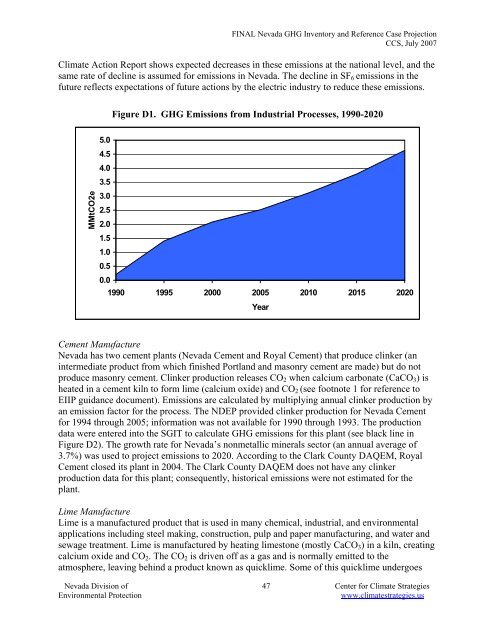Nevada Greenhouse Gas Inventory and Reference Case Projections
Nevada Greenhouse Gas Inventory and Reference Case Projections
Nevada Greenhouse Gas Inventory and Reference Case Projections
Create successful ePaper yourself
Turn your PDF publications into a flip-book with our unique Google optimized e-Paper software.
FINAL <strong>Nevada</strong> GHG <strong>Inventory</strong> <strong>and</strong> <strong>Reference</strong> <strong>Case</strong> Projection<br />
CCS, July 2007<br />
Climate Action Report shows expected decreases in these emissions at the national level, <strong>and</strong> the<br />
same rate of decline is assumed for emissions in <strong>Nevada</strong>. The decline in SF 6 emissions in the<br />
future reflects expectations of future actions by the electric industry to reduce these emissions.<br />
Figure D1. GHG Emissions from Industrial Processes, 1990-2020<br />
MMtCO2e<br />
5.0<br />
4.5<br />
4.0<br />
3.5<br />
3.0<br />
2.5<br />
2.0<br />
1.5<br />
1.0<br />
0.5<br />
0.0<br />
1990 1995 2000 2005 2010 2015 2020<br />
Year<br />
Cement Manufacture<br />
<strong>Nevada</strong> has two cement plants (<strong>Nevada</strong> Cement <strong>and</strong> Royal Cement) that produce clinker (an<br />
intermediate product from which finished Portl<strong>and</strong> <strong>and</strong> masonry cement are made) but do not<br />
produce masonry cement. Clinker production releases CO 2 when calcium carbonate (CaCO 3 ) is<br />
heated in a cement kiln to form lime (calcium oxide) <strong>and</strong> CO 2 (see footnote 1 for reference to<br />
EIIP guidance document). Emissions are calculated by multiplying annual clinker production by<br />
an emission factor for the process. The NDEP provided clinker production for <strong>Nevada</strong> Cement<br />
for 1994 through 2005; information was not available for 1990 through 1993. The production<br />
data were entered into the SGIT to calculate GHG emissions for this plant (see black line in<br />
Figure D2). The growth rate for <strong>Nevada</strong>’s nonmetallic minerals sector (an annual average of<br />
3.7%) was used to project emissions to 2020. According to the Clark County DAQEM, Royal<br />
Cement closed its plant in 2004. The Clark County DAQEM does not have any clinker<br />
production data for this plant; consequently, historical emissions were not estimated for the<br />
plant.<br />
Lime Manufacture<br />
Lime is a manufactured product that is used in many chemical, industrial, <strong>and</strong> environmental<br />
applications including steel making, construction, pulp <strong>and</strong> paper manufacturing, <strong>and</strong> water <strong>and</strong><br />
sewage treatment. Lime is manufactured by heating limestone (mostly CaCO 3 ) in a kiln, creating<br />
calcium oxide <strong>and</strong> CO 2 . The CO 2 is driven off as a gas <strong>and</strong> is normally emitted to the<br />
atmosphere, leaving behind a product known as quicklime. Some of this quicklime undergoes<br />
<strong>Nevada</strong> Division of 47 Center for Climate Strategies<br />
Environmental Protection<br />
www.climatestrategies.us
















